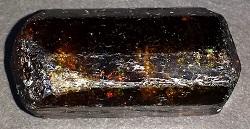A- |
B- |
C- |
D- |
E- |
F- |
G- |
H- |
I- |
J- |
K- |
L- |
M- |
N- |
O- |
P- |
Q- |
R- |
S- |
T- |
U- |
V- |
W- |
X- |
Y- |
Z |
DRAVITE:PHYSICAL CHARACTERISTICS:Color is light brown to dark brown. Crystal Habit is typically elongated three sided prisms. The terminations can be either a simple to complex trigonal pyramid or a flat basal face. The prism faces are striated lengthwise. In cross section, all tourmalines will appear predominantly triangular in shape with some crystals showing a hexagon. Doubly terminated crystals are hemimorphic meaning that the two ends of the crystal are not exactly alike. Massive forms can also be found. Transparency: crystals are translucent to opaque. Crystal System is Trigonal; 3m Hardness is 7 - 7.5 Specific Gravity is 3.2+ (slightly heavier than average) Cleavage is absent although there is basal parting. Fracture is uneven to conchoidal. Luster is vitreous. Associated Minerals include those associated with metamorphic rocks such as micas, feldspars and quartz. Other Characteristics: crystals are brittle and refractive indices = 1.62 and 1.68 . Notable Occurances include brazil and some other South American countries, and Africa. Best Field Indicators are crystal habit, triangular cross-section, color and hardness. Dravite is a little known species of the Tourmaline Group. The two best-known species of tourmalines are Schorl (black, iron rich) and Elbaite (various colors and sometimes cut for gems, lithium rich). Nearly all tourmaline jewelry is elbaite. Dravite is brown, and will sometimes produce rather large well-shaped crystals that are important specimens in a rock hound's collection.
|

